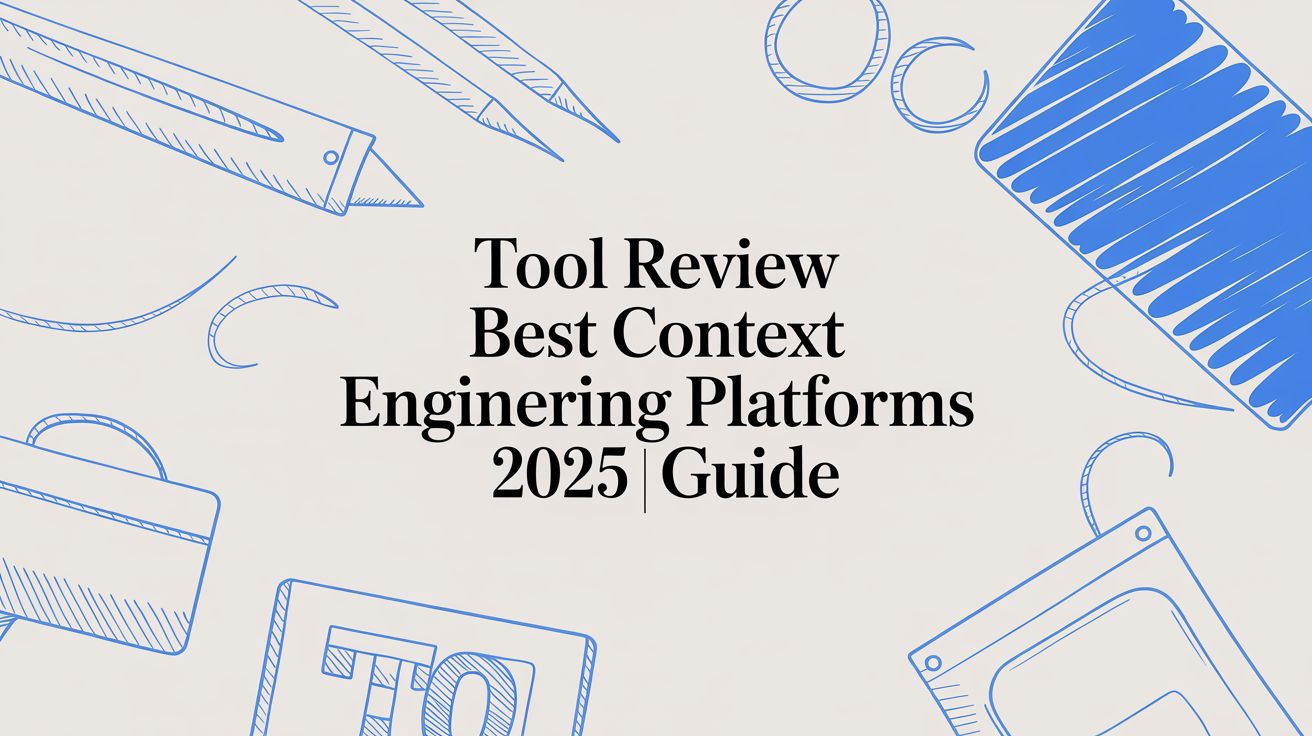In 2025, the conversation around AI development has decisively shifted from clever prompt writing to the disciplined practice of architecting intelligent context. The core of context engineering is providing an AI with its complete operational environment—including private codebases, APIs, and high-level objectives—not just a single query. This methodical approach is critical: teams are reporting up to an 80% reduction in AI hallucinations and dramatic cuts in wasted token consumption.
The transition is essential because modern AI agents and coding assistants fail without precise, persistent context. They simply cannot reason effectively about complex software tasks in a vacuum. A study by Accenture found that 77% of C-suite executives believe that without trusted data and AI, their organizations risk competitive disadvantage. Providing accurate context is the foundation of that trust.
This guide is a comprehensive, hands-on tool review of the best context engineering platforms for 2025. We move past marketing hype to deliver direct, practical analysis for developers, architects, and team leads building the next generation of AI.
Inside, you will find:
- In-depth Reviews: We evaluate twelve leading platforms, from IDE-native tools like the Context Engineer MCP to managed vector databases and observability suites such as LangSmith and Langfuse. Each review includes direct links and screenshots.
- Real-World Benchmarks: We compare platforms on critical metrics like token efficiency, retrieval accuracy, and their impact on reducing generation errors.
- Persona-Based Recommendations: Get tailored suggestions whether you are an indie developer, a technical lead architecting a system, or an engineering manager scaling a team.
Our goal is to help you select the right stack to build more reliable and efficient AI-powered features. Let’s dive into the platforms defining the future of AI development.
1. Context Engineering
Best For: Reliable, end-to-end AI feature development without context loss. Link: https://contextengineering.ai
Context Engineering emerges as our top recommendation for the best context engineering platforms in 2025, transforming how developers leverage AI for complex software development. It functions as a local Model Context Protocol (MCP) server that integrates directly into MCP-enabled IDEs like Cursor and VS Code. Its primary mission is to eliminate the persistent problem of context loss that plagues even the most advanced AI coding assistants, which can waste up to 40% of a developer’s time on rework according to industry reports.
Unlike tools that rely solely on vector embeddings or transient chat history, Context Engineering performs a deep, local analysis of your entire codebase. It infers architectural patterns, data flows, and coding conventions to build a comprehensive “mental model” of your project. This allows it to generate not just code snippets, but complete, executable plans for new features, from product requirements down to granular implementation tasks and validation tests. This structured approach aligns with the principles of providing AI with a persistent, rich operational environment.
Key Strengths and Use Cases
The platform’s standout capability is its structured, multi-phase planning. Before writing a single line of code, it produces a detailed blueprint that a human senior engineer would create. This plan is saved directly into your project, ensuring any AI agent you use (via Cursor, for example) maintains perfect continuity and follows the exact same strategy. The result is a dramatic reduction in hallucinations, conflicting edits, and wasted tokens on redundant explanations.
A key use case is building a complex, multi-layered feature, such as a new API endpoint with corresponding database migrations, service logic, frontend components, and tests.
Context Engineering acts like a virtual senior architect, breaking the work down into logical, testable steps. It ensures the AI doesn’t invent fake function names or produce mock implementations because it operates from a complete, accurate understanding of your existing code.
Internal benchmarks are impressive, reporting up to a ~25x increase in overall feature delivery speed. This isn’t just about coding faster; it’s about eliminating the back-and-forth of re-explaining context and fixing AI-generated errors. This approach marks a significant shift from traditional prompt engineering to a more robust, architectural methodology. For a deeper dive into this paradigm, you can learn more about the principles of Context Engineering .
Limitations and Practical Considerations
As an early-stage product, users can expect rapid iteration and a direct feedback loop with the founder, which is a major plus for shaping its future. However, it also means occasional rough edges are part of the experience. It is specifically designed for medium-to-large features where its planning capabilities provide the most value; it can be overkill for trivial, single-file UI changes.
Setup and Pricing:
- Requirements: An MCP-enabled IDE (like Cursor) and Node.js 16+.
- Privacy: 100% local. Your source code is never uploaded or exposed.
- Free Tier: Includes 10 tool calls, enough to plan and execute 1-2 complete features.
- PRO Tier: A limited-time early-bird price of $9/month (regularly $29/month) offers unlimited use and priority support, making it highly accessible for individual developers and teams.
2. LangSmith (by LangChain)
LangSmith, from the creators of LangChain, is an indispensable platform for developers already invested in its popular open-source framework. It acts as an all-in-one control panel for developing, debugging, and monitoring your LLM applications, offering deep visibility into every step of your context engineering pipeline. From tracing complex agentic workflows to evaluating prompt performance against datasets, LangSmith provides the granular feedback loop necessary for building production-grade AI.
Its core strength lies in its seamless integration with the LangChain and LangGraph ecosystems. If your application is built with these tools, instrumenting it for LangSmith is often a matter of setting a few environment variables. This tight coupling makes it one of the best context engineering platforms in 2025 for teams that need to move fast without sacrificing observability.
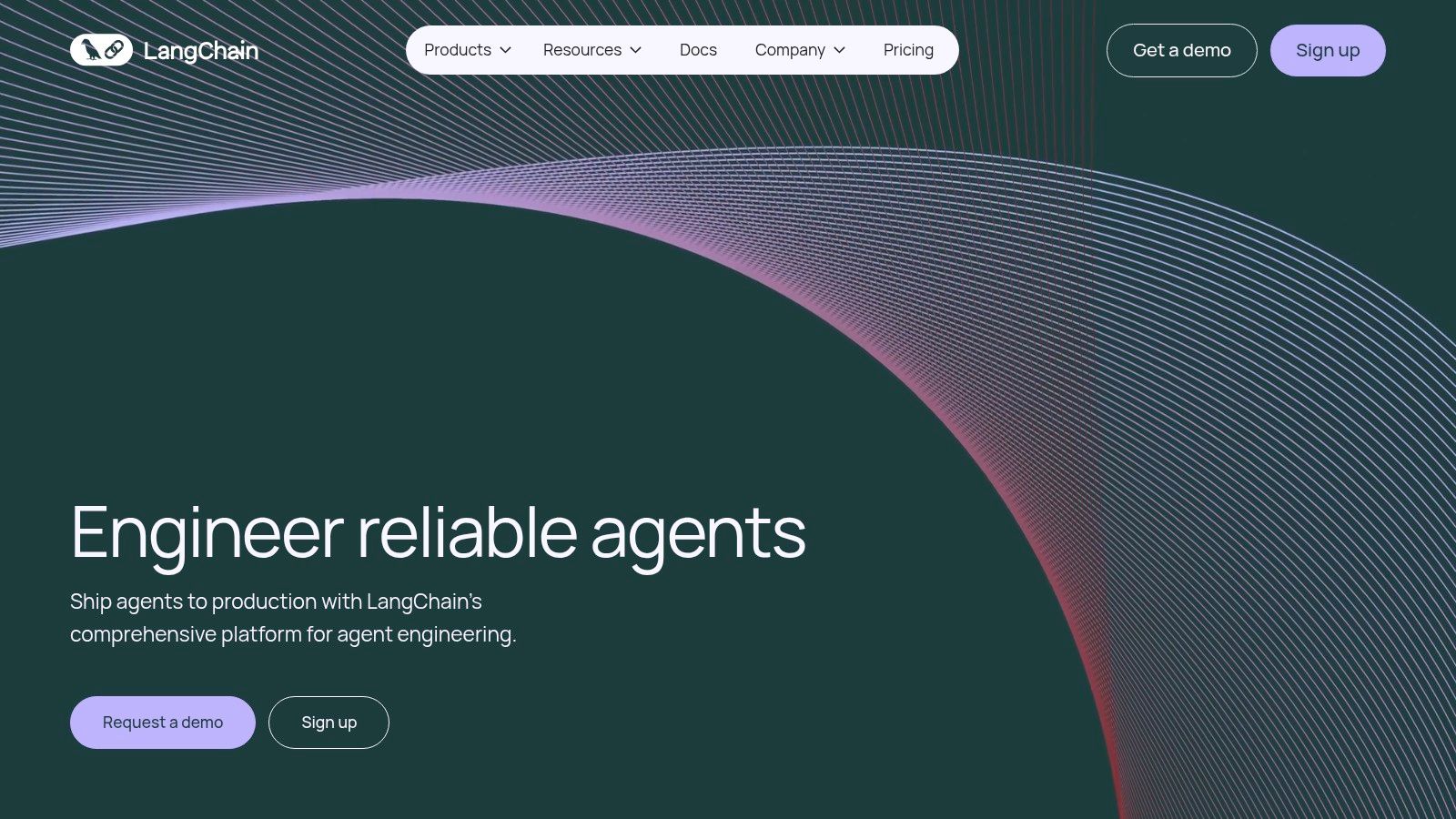
Key Features & User Experience
LangSmith’s user interface is clean and developer-centric, focusing on traces, datasets, and evaluations. The platform truly shines when debugging complex chains or agents built with LangGraph. You can visualize the entire execution flow, inspect the inputs and outputs of each node, and quickly identify where context is being lost or mishandled.
- End-to-End Tracing: Automatically captures every LLM call, function execution, and tool usage within your LangChain application.
- Prompt Hub: A centralized playground for iterating on and versioning prompts, crucial for effective context engineering. For a deeper dive, you can learn more about advanced prompt engineering techniques .
- Evaluation & Annotation: Create datasets to benchmark model performance and set up human-in-the-loop annotation queues to refine outputs.
- Flexible Deployment: Offers cloud, self-hosted, and hybrid options with data residency in the US or EU, addressing key enterprise security and compliance needs.
Pricing and Limitations
LangSmith operates on a freemium model. The “Developer” plan is free and generous, including 5,000 traces per month, making it perfect for indie developers. Paid plans scale based on trace volume, data retention, and seat count. While powerful, its greatest value is unlocked when you are committed to the LangChain stack; integrating it with custom-built frameworks requires more manual effort.
Website: https://www.langchain.com
3. LlamaIndex (LlamaCloud)
LlamaIndex, known for its powerful open-source data framework, offers LlamaCloud as a managed platform specifically designed to streamline Retrieval-Augmented Generation (RAG) pipelines. It excels at the foundational steps of context engineering: parsing, indexing, and retrieving information from complex, unstructured documents. LlamaCloud abstracts away much of the underlying infrastructure complexity, allowing developers to focus on building high-quality, context-aware applications.
Its standout feature is a production-ready, managed ingestion and retrieval service that turns raw data into queryable knowledge with just a few API calls. This makes it one of the best context engineering platforms in 2025 for teams that need to build sophisticated RAG systems without managing the intricate details of data chunking, embedding, and storage. The platform’s approach aligns well with modern standards for structured data interaction, as seen in emerging frameworks. For a deeper understanding of these standards, you can learn more about the Model Context Protocol .

Key Features & User Experience
LlamaCloud offers a pragmatic, API-first experience supported by robust SDKs for both Python and TypeScript. Its user interface is straightforward, focusing on managing data sources, pipelines, and API keys. The platform is designed to get developers from raw documents to a functioning RAG API as quickly as possible, providing useful presets for common document types like invoices or scientific papers to optimize parsing.
- Managed Ingestion & Retrieval: Simplifies the most complex parts of RAG, handling document parsing, chunking, embedding, and indexing automatically.
- Document-Specific Presets: Offers optimized parsing configurations for challenging formats like invoices, scientific papers, and dense technical docs.
- Credit-Based Metering: Provides granular, pay-as-you-go pricing for ingestion and retrieval actions, giving users control over costs.
- Enterprise-Ready: Features team plans, regional data options for compliance, and caching to improve performance and reduce operational costs.
Pricing and Limitations
LlamaCloud operates on a credit-based system, which offers flexibility but also introduces a learning curve. Costs are metered based on specific pipeline steps like parsing and indexing, and they can vary significantly depending on the chosen models and parsing modes. The “Starter” plan is free and includes 1 million credits to begin. Its primary limitation is its focus; it is a specialized RAG-as-a-service platform, not a full-stack observability tool like some competitors.
Website: https://www.llamaindex.ai
4. Pinecone
Pinecone is a fully managed, production-ready vector database that has become a cornerstone of the modern RAG stack. It abstracts away the complexity of managing vector indexes at scale, allowing developers to focus on building high-performance applications that require fast and accurate similarity search. Its serverless architecture and integrated inference capabilities make it a powerful backend for context retrieval.
As one of the most mature players in the vector database space, Pinecone is a top choice among the best context engineering platforms in 2025 for teams that require enterprise-grade reliability and a rich ecosystem. Its ability to handle billions of embeddings makes it suitable for demanding applications, from semantic search to complex generative AI systems.
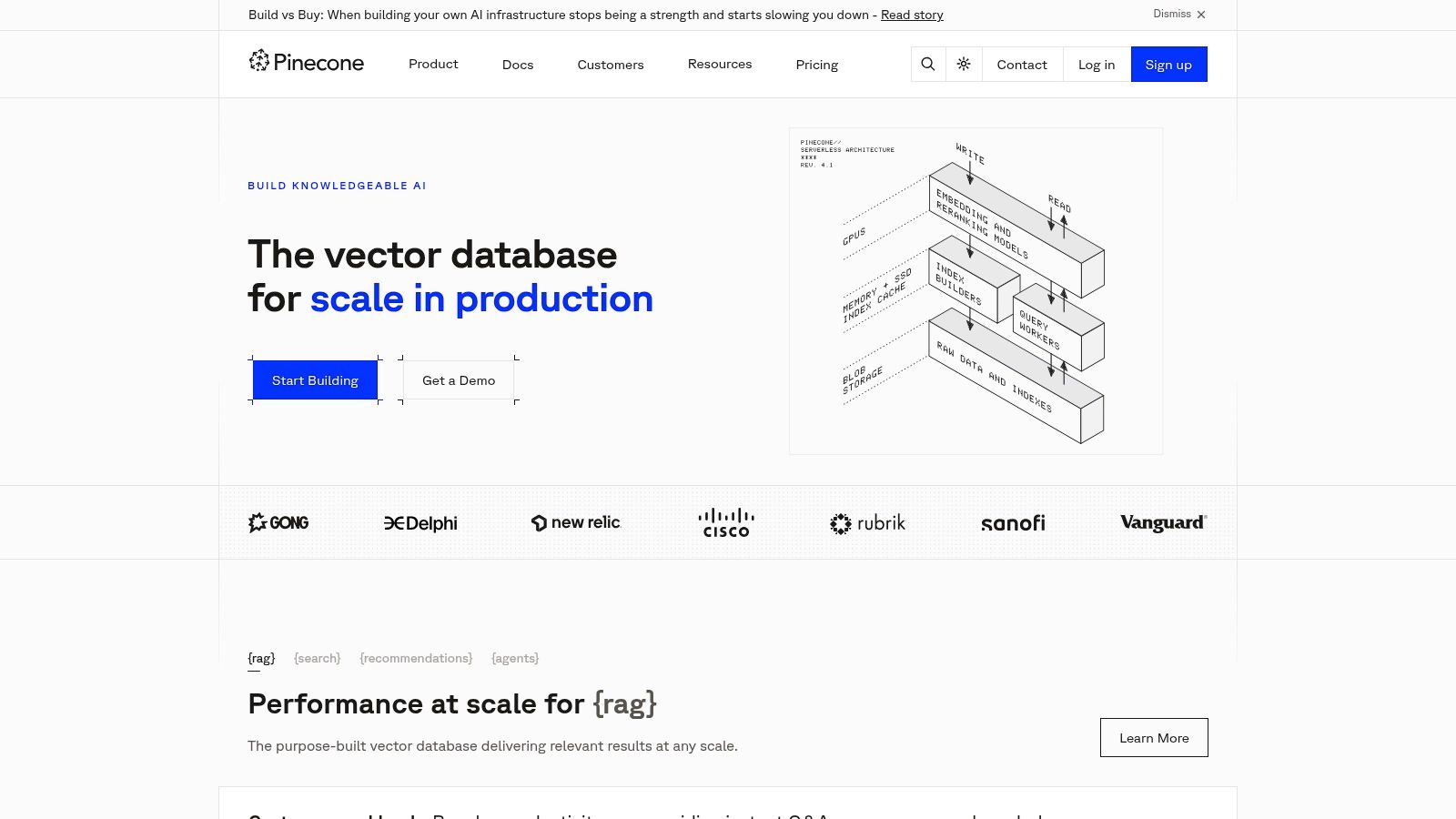
Key Features & User Experience
Pinecone’s dashboard and SDKs are designed for ease of use, enabling quick setup and integration. The platform excels at providing a reliable, low-latency service that scales automatically with demand. Features like namespace support and metadata filtering are crucial for building multi-tenant applications or refining search results, which is a key part of effective context engineering.
- Serverless Architecture: Automatically scales indexes up or down based on read/write units, ensuring you only pay for what you use.
- Integrated Inference APIs: Offers built-in support for embedding and reranking models, simplifying the RAG pipeline.
- Enterprise-Ready: Provides essential features for production environments, including SSO, RBAC, backups, and restores.
- Marketplace Integration: Available through major cloud providers like AWS Marketplace for streamlined billing and procurement.
Pricing and Limitations
Pinecone offers a free “Starter” tier to help developers get started. The paid “Standard” and “Enterprise” tiers are metered, with costs scaling based on data storage and usage. While the platform is incredibly powerful, it’s designed for production workloads, and paid tiers have minimum monthly usage commitments. Advanced features and high-volume usage can increase costs, requiring careful monitoring as your application grows.
Website: https://www.pinecone.io
5. Weaviate Cloud
Weaviate Cloud offers a managed, serverless vector database that serves as a powerful and scalable foundation for retrieval-augmented generation (RAG) systems. It simplifies one of the most critical components of context engineering: storing and retrieving relevant information efficiently. By handling the complexities of vector storage and search, Weaviate allows developers to focus on building intelligent applications rather than managing infrastructure.
Its key differentiator is a transparent pricing model directly tied to the dimensions of the vectors you store, coupled with built-in hybrid search capabilities. This makes it an excellent choice for projects ranging from quick prototypes in its free sandbox to high-availability enterprise deployments. For teams building sophisticated context pipelines, a reliable vector store like Weaviate is a non-negotiable part of the stack, making it one of the best context engineering platforms in 2025 for data-intensive applications.

Key Features & User Experience
The user experience is centered around developer productivity, offering a straightforward path from a free sandbox cluster to a production-ready, highly available system. The platform provides a simple cost estimator, removing the guesswork often associated with cloud service billing. This transparency is a major plus for developers and engineering managers planning their budgets.
- Serverless Vector Database: Fully managed infrastructure that scales automatically, abstracting away server management.
- Built-in Hybrid Search: Combines keyword-based (BM25) and vector search out-of-the-box for more accurate and contextually aware retrieval.
- Flexible Deployment Options: Offers serverless, dedicated enterprise cloud, and Bring-Your-Own-Cloud (BYOC) models to meet diverse security and operational needs.
- Generous Free Tier: Includes a free sandbox cluster that never sleeps, perfect for prototyping and small-scale projects without initial investment.
Pricing and Limitations
Weaviate’s pricing is commendably transparent, based on stored vector dimensions and the selected Service Level Agreement (SLA) tier. The free sandbox is a significant advantage for getting started. However, as your data grows or you require higher availability, costs can increase. The dependency on vector dimensionality and SLA tiers means teams must carefully estimate their storage needs to predict expenses accurately. While high-availability is a strength, its default inclusion in higher tiers may add costs for use cases that don’t strictly require it.
Website: https://weaviate.io
6. Qdrant Cloud
Qdrant Cloud provides a high-performance, managed vector database service built on its popular open-source engine. While not a full-stack context engineering platform itself, it is a critical infrastructure component for storing and retrieving the vectorized context that powers Retrieval-Augmented Generation (RAG). Its strength lies in offering a managed, scalable, and resilient environment for the vector search backbone of any serious LLM application.
What makes Qdrant Cloud a top choice in 2025 is its developer-friendly approach and deployment flexibility. It solves the operational headache of managing a specialized database, allowing teams to focus on refining their context retrieval strategies rather than on infrastructure maintenance. The truly free starter cluster is a massive advantage for prototyping and small-scale projects.

Key Features & User Experience
The Qdrant Cloud dashboard is straightforward, enabling users to deploy, monitor, and scale clusters with a few clicks. The user experience is designed to get developers up and running quickly, abstracting away the complexities of database administration. Its performance, especially with advanced filtering and large-scale search, makes it a reliable choice for production systems.
- Generous Free Tier: Offers a 1GB forever starter cluster with no credit card required, perfect for testing and indie development.
- Multi-Cloud & Hybrid Deployment: Provides managed clusters on AWS, GCP, and Azure, plus a hybrid option that connects to your own infrastructure for data sovereignty.
- Advanced Filtering & Search: Supports powerful pre-filtering capabilities, allowing you to combine vector search with structured metadata for highly relevant context retrieval.
- Scalability & High Availability: Paid clusters offer automatic scaling, backups, and high-availability configurations to ensure your application remains responsive and resilient.
Pricing and Limitations
Qdrant Cloud’s pricing is transparent and usage-based. The free starter cluster is a significant benefit, but it is resource-limited and may be suspended if idle for long periods. For production workloads, you will need to upgrade to a paid Standard cluster, which is priced based on compute and storage resources. While it excels as a vector database, it is just one piece of the context engineering puzzle; you still need to integrate it with other tools for orchestration, evaluation, and monitoring.
Website: https://qdrant.tech
7. Zilliz Cloud (Managed Milvus)
Zilliz Cloud provides a managed, enterprise-grade vector database service built on Milvus, the popular open-source vector database. It is a critical infrastructure component for Retrieval-Augmented Generation (RAG), enabling developers to store, index, and query massive volumes of embedding vectors with high speed and scalability. For context engineering, Zilliz Cloud acts as the long-term memory for your LLM, ensuring that the most relevant documents and data are retrieved to build rich, accurate prompts.
Its primary advantage lies in its enterprise-ready features and deployment flexibility, making it a top choice for organizations with stringent security, compliance, and operational requirements. By offloading the complexity of managing a high-performance vector database, teams can focus on refining their context retrieval strategies, which is a core tenet of building the best context engineering platforms in 2025.
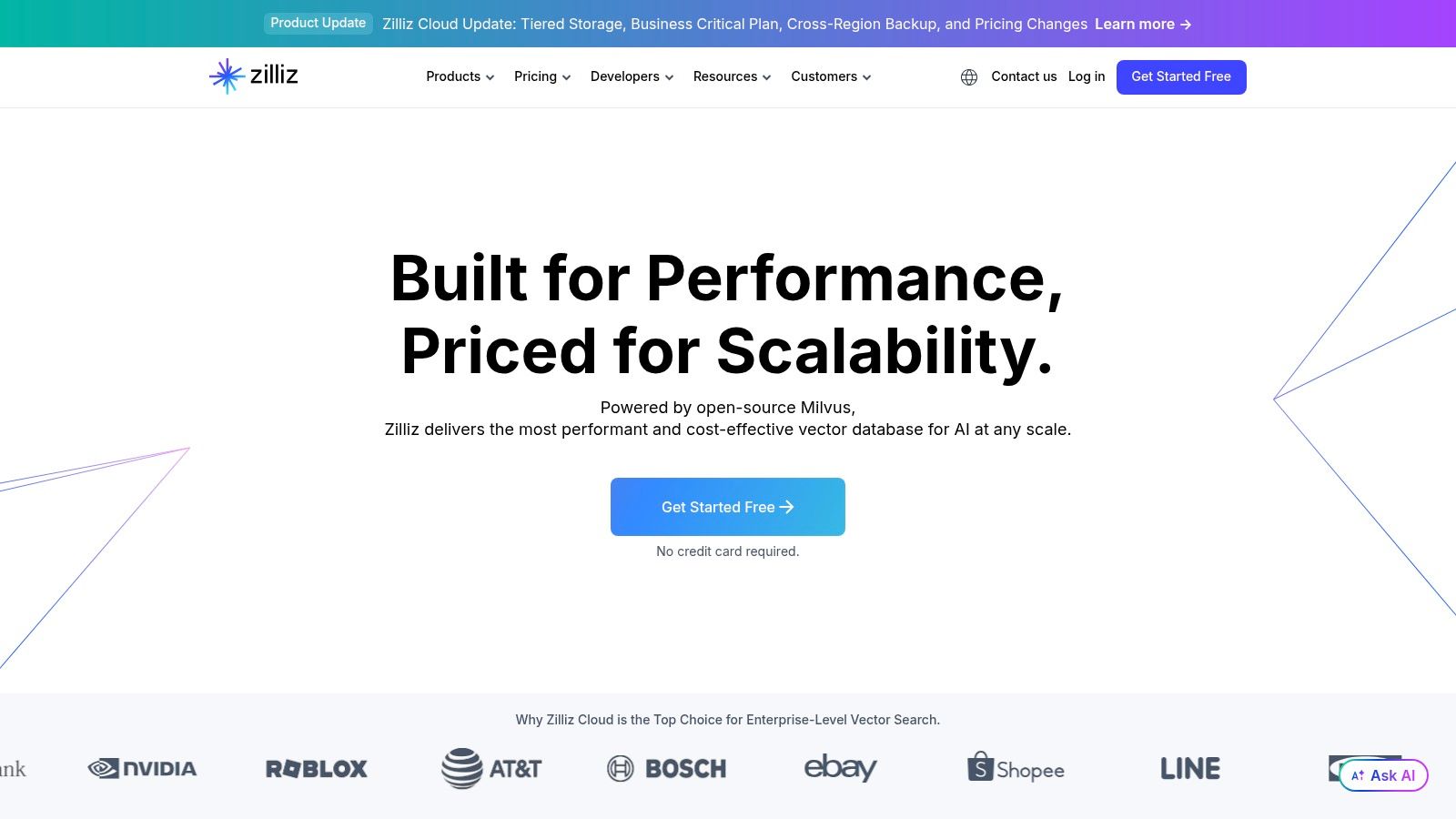
Key Features & User Experience
The Zilliz Cloud dashboard is straightforward, allowing users to quickly provision and manage Milvus clusters across major cloud providers. The platform is designed for operational resilience and security, abstracting away the underlying infrastructure management so developers can focus purely on data and queries.
- Flexible Deployment Models: Offers serverless, dedicated, and bring-your-own-cloud (BYOC) options to fit different performance, security, and cost requirements.
- Enterprise-Grade Security: Provides features like HIPAA readiness, multi-region replication for disaster recovery, and Point-in-Time Recovery (PITR) for data protection.
- Simplified Billing: Integrates with AWS, GCP, and Azure marketplaces, allowing for consolidated billing and use of existing cloud credits.
- Cost Management Tools: Includes a detailed pricing calculator to help teams forecast storage and compute costs accurately based on their specific usage patterns.
Pricing and Limitations
Zilliz Cloud offers a “Starter” serverless plan which is free and includes one cluster unit, making it accessible for initial development and small projects. Paid plans scale based on the deployment model (serverless vs. dedicated), cluster size, and data volume. Pricing can be complex as it varies by cloud provider and region, so using their calculator is essential for budgeting. While the documentation is extensive, some examples are tailored to specific cloud regions, which may require minor adjustments.
Website: https://zilliz.com
8. Azure AI Search
Azure AI Search is Microsoft’s enterprise-grade solution for building sophisticated search and retrieval applications, making it a foundational component for any context engineering strategy built on the Azure cloud. It excels at combining traditional keyword search with modern vector-based and semantic search capabilities, providing a robust backbone for Retrieval-Augmented Generation (RAG) systems. For organizations already committed to the Azure ecosystem, it offers unparalleled integration with services like Azure OpenAI and Microsoft Fabric.
Its core strength lies in its ability to manage and query vast, heterogeneous datasets securely and at scale. By leveraging its semantic ranker and agentic retrieval features, developers can significantly improve the relevance and accuracy of the context fed to large language models. This makes Azure AI Search one of the best context engineering platforms in 2025 for enterprises that require predictable performance, security, and tight integration with their existing Microsoft technology stack.
Key Features & User Experience
Azure AI Search is managed through the Azure Portal, which provides a comprehensive interface for creating indexes, managing data sources, and configuring cognitive skills. While the portal is powerful, the primary interaction for developers happens via its well-documented REST APIs and SDKs, which allow for deep integration into custom applications. The platform is designed for reliability and scalability rather than a flashy UI.
- Hybrid Search: Seamlessly combines full-text, vector, and semantic search in a single query to deliver highly relevant results from complex datasets.
- Semantic Ranker: A powerful add-on that uses deep learning models to re-rank results based on contextual meaning, drastically improving retrieval quality for RAG.
- Scalable Architecture: Offers multiple SKUs (Free, Basic, Standard, Storage-Optimized) that scale through Search Units (SUs), allowing you to balance cost and performance with replicas and partitions.
- Deep Ecosystem Integration: Natively connects with Azure OpenAI, Azure Blob Storage, and other Microsoft services for streamlined data ingestion and application development.
Pricing and Limitations
Azure AI Search pricing is based on a complex but predictable model of hourly Search Unit (SU) consumption across different SKUs. The Free tier is suitable for initial development, but production workloads require a paid SKU. While the model offers granular control over costs, the matrix of SKUs, replicas, partitions, and add-on features like the semantic ranker can be complex to navigate initially. Its tight coupling with the Azure ecosystem means it is less ideal for multi-cloud or platform-agnostic development teams.
Website: https://azure.microsoft.com/products/ai-search
9. Amazon OpenSearch Service (Serverless, Vector Search)
For developers building within the AWS ecosystem, Amazon OpenSearch Service provides a powerful, native solution for vector search and retrieval, a cornerstone of modern context engineering. Its serverless offering removes the operational burden of managing clusters, allowing teams to focus on indexing and querying contextual data for their RAG pipelines. It handles the complex infrastructure, scaling automatically to meet demand.
The service’s main advantage is its deep integration with the entire AWS stack. Connecting your vector database to services like S3 for data storage, Lambda for processing, and SageMaker for model endpoints is seamless. This tight coupling makes it one of the best context engineering platforms for organizations already committed to AWS, providing a unified environment for building, deploying, and securing sophisticated AI applications.
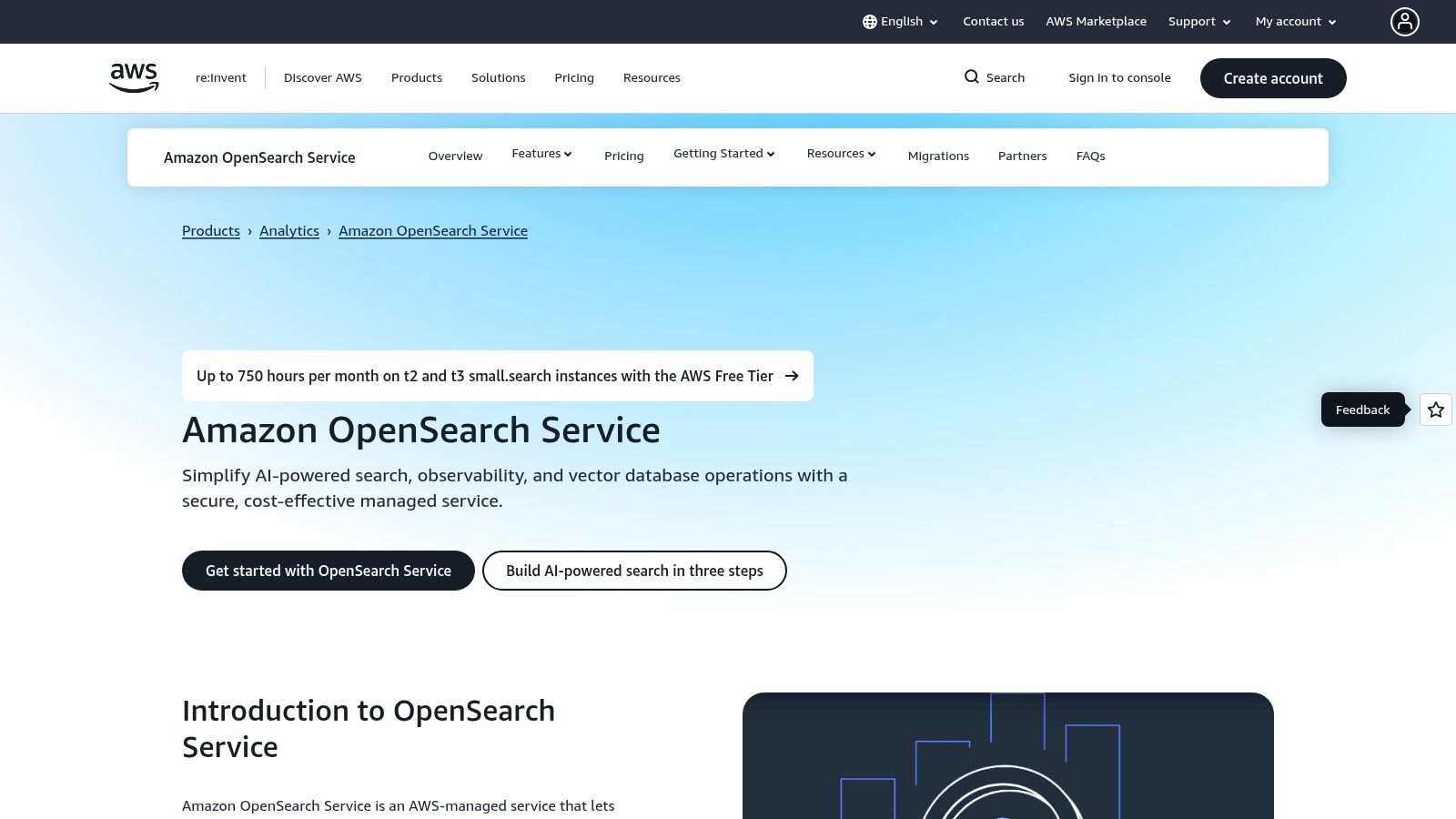
Key Features & User Experience
The user experience is typical of AWS, managed through the console, CLI, or SDKs, which will feel familiar to existing users. Setting up a serverless collection is straightforward, abstracting away the underlying complexities of sharding and replication. The platform is designed for performance and cost-efficiency at scale.
- Serverless Vector Engine: Automatically provisions and scales resources, eliminating cluster management and operational overhead.
- Pay-as-you-go Model: Compute is metered in OpenSearch Compute Units (OCUs), and storage is billed per GB/month, preventing over-provisioning.
- Cost-Saving Compression: Features like binary and FP16 vector compression significantly reduce memory usage and lower storage costs.
- AWS Ecosystem Integration: Natively connects with AWS security (IAM), networking (VPC), and other essential services for enterprise-grade deployments.
Pricing and Limitations
The serverless model is based on usage, which provides flexibility but requires careful monitoring to manage costs. Understanding how your indexing and search workloads translate to OCU consumption is key to predicting expenses. While OpenSearch is a robust open-source tool, the most advanced features and easiest management experience are within the managed AWS service. Additionally, feature availability and specific pricing can differ across AWS regions, which is a consideration for global applications.
Website: https://aws.amazon.com/opensearch-service
10. Humanloop
Humanloop is an enterprise-grade platform built for teams that need robust governance and operational control over their LLM-powered applications. It excels at bridging the gap between development and production by providing powerful tools for prompt management, rigorous evaluation, and continuous observability. The platform is designed to help teams systematically improve their models’ performance by treating prompt and context engineering as a core part of the software development lifecycle.
Its standout feature is its evaluation-first approach. Humanloop enables teams to create extensive datasets, run online and offline evaluations, and generate detailed reports to measure the impact of every change. This makes it one of the best context engineering platforms in 2025 for organizations that require a methodical, data-driven workflow for deploying and maintaining reliable AI products at scale.

Key Features & User Experience
The user interface is geared towards product teams, offering a collaborative environment to iterate on prompts, manage datasets, and review model outputs. Humanloop integrates directly into CI/CD pipelines, allowing teams to automate testing and prevent regressions before they reach production. The platform’s ability to support multiple LLM providers ensures flexibility and avoids vendor lock-in.
- Multi-LLM Playground: A unified space to experiment, version, and collaborate on prompts with support for function calling.
- Systematic Evals & Ops: Comprehensive online and offline evaluation frameworks with detailed reporting and CI/CD integration.
- Data Annotation Workflows: Create and manage datasets with built-in tools for annotation, which is crucial for refining context strategies.
- Enterprise-Ready Deployment: Offers SOC2 compliance and flexible deployment options, including VPC and self-hosted, to meet strict security requirements.
- Governance & Observability: Provides deep insights into LLM behavior in production, helping teams monitor costs, latency, and quality.
Pricing and Limitations
Humanloop offers a free trial to get started, but its full-featured plans are enterprise-focused and require contacting their sales team for pricing. A significant consideration is that users must bring their own model API keys, meaning the cost of LLM usage is separate from the platform subscription. While its evaluation and governance features are top-tier, the platform is best suited for established teams rather than individual developers on a tight budget.
Website: https://humanloop.com
11. Langfuse
Langfuse is a powerful open-source observability and analytics platform for LLM applications, offering a compelling alternative for teams that value flexibility and control. It provides a comprehensive suite of tools for tracing, debugging, evaluating, and managing prompts, making it an excellent choice for refining complex context engineering pipelines. Its open-source nature (MIT license) allows for complete data sovereignty via self-hosting, a critical feature for organizations with strict compliance or security requirements.
This commitment to open-source, combined with a transparent, usage-based cloud offering, makes Langfuse one of the best context engineering platforms for teams wanting to avoid vendor lock-in. It provides the core observability features needed for production-grade AI without forcing you into a specific development framework, offering SDKs for major languages like Python and TypeScript/JavaScript.

Key Features & User Experience
The Langfuse UI is clean and analytical, presenting traces, metrics, and datasets in an intuitive dashboard. It excels at providing detailed views of LLM interactions, allowing you to inspect every input, output, and latency metric. This granular view is essential for diagnosing issues where context is being diluted or incorrectly passed between steps.
- Open-Source & Self-Hostable: The MIT-licensed core platform can be deployed on your own infrastructure, giving you full control over your data and operations.
- Detailed Tracing: Capture comprehensive traces of your LLM calls, including token counts, costs, and latency, to pinpoint performance bottlenecks.
- Prompt Management: A central hub for creating, versioning, and deploying prompts, which is key for systematic context optimization.
- Evaluation & Datasets: Build and run evaluations against datasets to quantitatively measure the impact of prompt changes and model updates.
Pricing and Limitations
Langfuse offers a generous free tier on its cloud platform, including 50,000 observations per month, making it highly accessible for individual developers and small projects. Paid plans are based on a transparent, usage-based unit system, with add-ons available for team features like SSO and RBAC. While the unit-based metering is fair, it does require careful monitoring to manage costs as your application scales. Furthermore, advanced enterprise security features are typically part of paid add-ons.
Website: https://langfuse.com
12. Contextual AI
Contextual AI is a powerful platform designed for productionizing LLM applications, focusing specifically on reliable agentic workflows and sophisticated retrieval-augmented generation (RAG). It provides robust infrastructure for managing complex data ingestion pipelines and offers flexible deployment models tailored to different performance needs. This makes it a strong contender among the best context engineering platforms in 2025 for teams that need to scale from a proof-of-concept to a production-ready system with predictable performance.
Its key differentiator is the dual offering of on-demand, pay-as-you-go access and provisioned throughput. The on-demand model is perfect for development and early-stage applications, offering unlimited workspaces and agents to encourage experimentation. For mission-critical workloads, the provisioned option guarantees consistent quality of service and throughput, solving a major headache for enterprises that cannot tolerate performance variability.
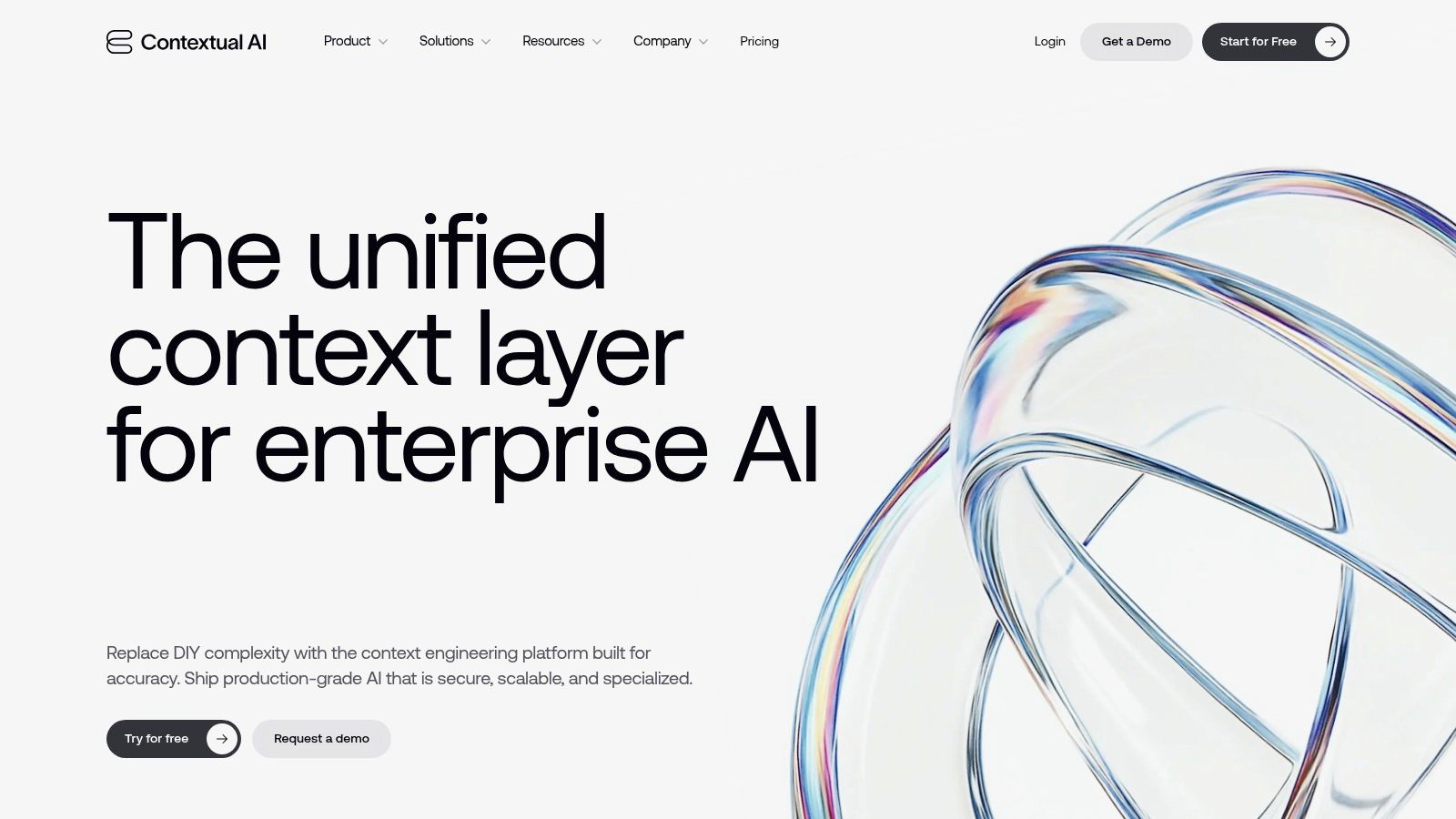
Key Features & User Experience
Contextual AI is built for developers who need to productize retrieval and user-context analytics efficiently. The platform abstracts away much of the underlying complexity of data pipelines and infrastructure management, allowing teams to focus on building intelligent agents. The initial experience is smooth, with starter credits encouraging users to test the full capabilities without immediate commitment.
- Dual Throughput Models: Choose between a pay-as-you-go plan for flexibility or provisioned throughput for predictable, low-latency performance at scale.
- Unlimited On-Demand Entities: The on-demand tier includes unlimited users, workspaces, agents, and datastores, promoting collaboration and expansive development.
- Robust Ingestion Pipelines: Natively handles document ingestion and analytics, simplifying the process of feeding proprietary data into your context engineering workflows.
- Production-Focused: The platform is engineered to move beyond simple prototypes, providing the reliability needed to launch and manage user-facing AI products.
Pricing and Limitations
The platform starts with a free credit model, allowing for thorough evaluation. The on-demand pricing is usage-based, with costs varying depending on token counts, which can be unpredictable for high-volume applications. While the provisioned plans offer stability, they require a monthly commitment and are arranged through a sales process, which adds friction compared to a self-serve upgrade. This structure makes it ideal for projects that have a clear path to monetization.
Website: https://contextual.ai
2025 Comparison: Top 12 Context Engineering Platforms
| Product | Core function | Target audience | Key strengths (USP) | Limitations & pricing |
|---|---|---|---|---|
| Context Engineering | MCP server that analyzes repo locally and supplies precise project context to AI agents; auto-generates PRDs, blueprints, tasks & tests | Indie devs, engineering leads, teams building medium→large features | Privacy-first local analysis, eliminates hallucinations, end-to-end executable plans, token-efficient, 1–2 min no-code setup | Early-stage (rapid iteration), requires MCP-enabled IDE & Node.js 16+, Free (10 tool calls) + PRO ~ $9/mo early‑bird (anchor $29) |
| LangSmith (LangChain) | LLM observability, tracing, evaluations, prompt hub and managed agent deployment | LangChain users, ML/product teams, enterprises | Deep LangChain integration, trace/versioning, managed agents, regional residency | Pricing scales with trace retention & deployments; best when using LangChain; per-seat/metered tiers |
| LlamaIndex (LlamaCloud) | Managed RAG: parsing, indexing, retrieval, evaluators and agents with SDKs | Teams building document RAG pipelines | Presets for doc types, TS/Python SDKs, granular action-based pricing | Credit-based metering learning curve; costs vary by parsing mode & model choice |
| Pinecone | Fully managed vector DB with serverless indexes, integrated embeddings/rerank/inference | Production RAG teams, enterprises | Mature ecosystem, integrated inference, $300/21‑day trial, SSO/RBAC/backups | Minimum monthly usage on paid tiers; advanced features add cost as scale grows |
| Weaviate Cloud | Serverless vector DB with built-in embeddings & hybrid search | Prototyping → enterprise teams | Free sandbox, simple cost estimator tied to stored vectors, BYOC & SLA tiers | Pricing depends on vector dimensionality and SLA selection |
| Qdrant Cloud | Managed vector DB (open-source core) with free starter cluster & multi-cloud support | Developers wanting open-source core + managed cloud | Truly free 1GB starter (no card), multi-cloud/hybrid, HA & backups | Free tier limited and can suspend if idle; advanced features need paid clusters |
| Zilliz Cloud (Managed Milvus) | Managed Milvus with serverless, dedicated, BYOC and enterprise features | Regulated industries, enterprises needing compliance | HIPAA readiness, multi-region replication, PITR, marketplace billing | Pricing varies by region/cluster; requires cost calculator for estimates |
| Azure AI Search | Enterprise search + vector/RAG integrated into Azure AI & Fabric | Microsoft/Azure customers, enterprises | Semantic ranking, agentic retrieval, predictable Search Unit (SU) billing, enterprise SLAs | Complex SKU and metering matrix; some features billed separately |
| Amazon OpenSearch Service | AWS-native vector search & analytics with serverless collections (OCU metering) | AWS customers, teams preferring serverless ops | Serverless model, AWS ecosystem integration, vector compression options | OCU-based cost modeling required; regional feature/pricing differences |
| Humanloop | Prompt management, evaluations, LLM observability and governance | Product teams, enterprises needing governance & security | Strong eval/CI workflows, VPC/self-host options, SOC2/enterprise features | Sales-led pricing beyond trial; customers pay model/API costs separately |
| Langfuse | Open-source + cloud LLM tracing, evaluations, prompt mgmt & analytics | Teams wanting self-host OSS control or hosted analytics | MIT-licensed OSS self-host, transparent unit pricing, free/OSS options | Unit-based metering needs monitoring at scale; enterprise add-ons may cost extra |
| Contextual AI | On-demand or provisioned throughput platform for agents, ingestion & analytics | Teams needing predictable throughput or pay-as-you-go models | Unlimited users/workspaces on on‑demand, provisioned QoS option, ingestion pipelines | Query cost varies with tokens; provisioned plans require monthly commitments via sales |
Our Final Verdict & How to Choose Your Platform
We’ve explored a dozen powerful platforms, each tackling the context challenge from a unique angle. From the scalable vector search of Pinecone and Weaviate to the deep LLM pipeline visibility of LangSmith and Langfuse, the market is rich with solutions. Your final choice doesn’t come down to finding a single “best” tool, but rather identifying your primary bottleneck and aligning it with the right platform. Making a strategic decision now is crucial, as our 2025 review of the best context engineering platforms shows that the right architecture can dramatically accelerate your development lifecycle.
The key takeaway is that “context engineering” isn’t a monolithic problem. It’s a spectrum of challenges requiring specialized tools. One team might struggle with retrieving external documents, while another faces constant hallucinations when generating code that needs to understand a complex, evolving repository.
Choosing Your Path: Three Core Scenarios
To simplify your decision, consider which of these common scenarios most accurately reflects your needs. Each path points toward a specific category of tools we’ve reviewed.
1. You Need to Ground Your AI in External Knowledge (The RAG Path)
If your primary goal is to build applications that can accurately answer questions or generate content based on a large corpus of external documents, your focus should be on Retrieval-Augmented Generation (RAG). Your main challenge is efficient data ingestion, indexing, and retrieval.
- Your Best Bets:
- Managed Vector Databases: Platforms like Pinecone, Weaviate Cloud, and Qdrant Cloud are your workhorses. They offer mature, scalable, and high-performance vector search infrastructure, letting you focus on the application logic rather than database management.
- All-in-One Frameworks: LlamaIndex (and LlamaCloud) provides a comprehensive framework that simplifies the entire RAG pipeline, from data connectors to advanced retrieval strategies. This is a great starting point for teams wanting to build robust RAG systems quickly.
- Enterprise-Grade Search: For organizations already embedded in a major cloud ecosystem, Azure AI Search or Amazon OpenSearch Service provide powerful, integrated solutions with strong security and compliance features.
2. You Need to Understand and Debug Your LLM Operations (The Observability Path)
When your LLM-powered application is live but behaving unpredictably, your problem shifts from creation to maintenance and optimization. You need to trace requests, analyze costs, evaluate performance against benchmarks, and pinpoint the root cause of failures or poor responses.
- Your Best Bets:
- LLM-Native Observability: Langfuse and LangSmith are the clear leaders here. They provide granular tracing, cost analysis, and evaluation frameworks specifically designed for the complexities of LLM chains and agentic workflows. They give you the “why” behind your AI’s behavior.
- User Feedback & Finetuning: Humanloop extends observability into a full feedback loop, allowing you to collect user data, create evaluation sets, and finetune models based on real-world performance.
3. You Need to Build and Modify Features Within Your Codebase (The Code-Native Path)
This is the most intimate form of context engineering. Your challenge isn’t external data; it’s the intricate web of dependencies, logic, and style within your own project. AI coding assistants often fail here, hallucinating non-existent functions or producing code that breaks the existing architecture because they lack a deep, persistent understanding of the internal codebase context.
- Your Best Bet:
- IDE-Native MCP Tools: This is where Context Engineering stands alone. By implementing the Model Context Protocol (MCP) directly within your IDE, it acts as a virtual architect for your AI assistant. It doesn’t manage external documents; it masters your codebase’s internal structure. This approach is designed to solve the “last mile” problem of AI-driven development: generating production-ready code for complex features, automating entire pull requests, and achieving a 90% reduction in token waste and hallucinations. It ensures your AI partner never loses its place, keeping your code 100% private on your local machine.
Ultimately, the best context engineering platform for you in 2025 is the one that solves your most pressing and costly problem. Define that problem first, and your choice will become clear.
Ready to stop fighting your AI coding assistant and start shipping complex features with automated, context-aware precision? Context Engineering is the only IDE-native platform built on the Model Context Protocol, designed to give your AI a perfect, persistent understanding of your entire codebase. Try our free tier and experience the future of software development today.
